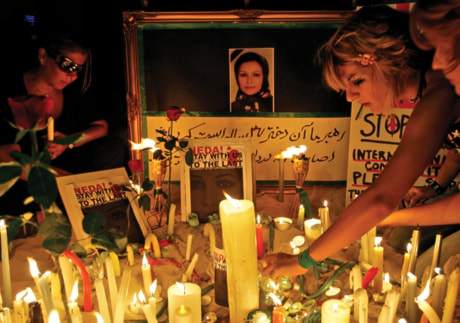The grisly video of 26-year-old Neda Agha-Soltan dying in a Tehran street, shot down by a government thug, has already been seen by millions of Iranians.
If the protesters against the alleged rigging of the recent election needed a dramatic image of martyrdom – and such images have a special resonance in Iran -- they now have one. But things are not quite so simple.
Her death, all the more affecting because she was not actually a protester but just trapped in the midst of the demo, has enraged many people, but it has also frightened them.
She was only one of 10 people
killed on Saturday, June 21, in Tehran by the police and the Basiji (the volunteer militia that normally serves as the regime’s morality police), but hers is the death that you can actually watch.
It was very fast, very ugly, and clearly quite arbitrary. If this is what happens to innocent bystanders, are you sure you want to go out and demonstrate again tomorrow?
The conventional wisdom says that in Iran such deaths only fuel popular anger and make the demos grow bigger, and that is certainly what happened during the struggle to overthrow the Shah of Iran 30 years ago. But there were only hundreds of demonstrators, not hundreds of thousands, on the streets of Tehran in the days after Neda’s death.
The regime has now nailed its colours to the mast: Supreme Leader Ayatollah Ali Khamenei has said that he will back President Mahmoud Ahmedinejad’s disputed election victory come what may.
There will not be a compromise in which the elections are re-run, maybe with a different outcome that makes Mir Hossein Mousavi, the opposition leader, the new president, but leaves Ali Khamenei and the basic principles of the “Islamic revolution” in place.
The regime’s heavy artillery, a parallel army called the Revolutionary Guards, has now been deployed on the streets, and its website makes it clear that it is willing to kill demonstrators: “The Guards will firmly confront in a revolutionary way rioters and those who violate the law.”
In Iran, the phrase “in a revolutionary way” instantly recalls the tens of thousands of alleged enemies of the new regime who were killed in mass hangings in 1989.
It is the regime that has deliberately raised the stakes, from a mere dispute about the outcome of an election to an existential struggle for the regime’s survival. It is a gamble, of course, for there are many young Iranians who would be willing to fight it out on that ground – but their leaders are not.
All three presidential candidates who believe they were cheated in the election are stalwart supporters of the Islamic regime. How could they be otherwise, when all presidential candidates are vetted by the Guardian Council for their revolutionary and Islamic dedication?
Mousavi was prime minister during the war with Iraq in 1980-88. Mohsen Rezaie is a former commander of the Revolutionary Guards. Even Mehdi Karroubi, the most liberal of the candidates, is a cleric who has served the revolution faithfully, if critically.
If it comes down to the survival of the Islamic revolutionary dispensation that they have devoted their lives to building, Mousavi, Rezaie and Karroubi are all ultimately on the same side of the barricades as Khamenei and Ahmadinejad. That is precisely what it’s coming down to, by the bold or desperate decision (take your pick) of Ali Khamenei.
As he intends, it leaves the young people in the streets (60 per cent of Iranians are under 30) without leaders.
You could hear the anguish in Mousavi’s open letter to the Guardian Council, which is supposedly investigating the election of June 12: “We are not against the Islamic system and its laws but against lies and deviations, and just want to reform it.” And he told his followers: “Protesting against lies and fraud is your right, (but) in your protests continue to show restraint.”
Nor did he tell them when they should next come out on the street to protest.
As more information becomes available, it looks likelier and likelier that there was massive rigging of the polls.
Mehdi Karroubi, for example, got 55.5 per cent of the votes in his home province of Lorestan in the last presidential election in 2005.
This time, according to the official figures, he got only 4.6 per cent, with most of the remainder shifting to Ahmadinejad. That is not remotely credible, nor could it have happened by accident.
It now seems likely that Khamenei and Ahmadinejad knew in advance that the latter’s re-election bid was doomed, and rigged the election to “save the Islamic regime,” or at least their version of it. Nothing could have been clumsier or more drastic than the intervention that they made, but it may have served its purpose, at least in the short run.
The protesters know they have been cheated, but without leaders or organization they may not be able to continue.
We will know if it’s really over on July 31, 40 days after the killing of Neda Agha-Soltan.
In the Shia tradition, that’s when the 40 days of mourning end.
During the revolt against the Shah, that was when the masses came out into the streets again to remember their martyrs.
The game is still afoot, but the young, predictably, have been betrayed yet again by their elders.
Gwynne Dyer is a London-based independent journalist.
